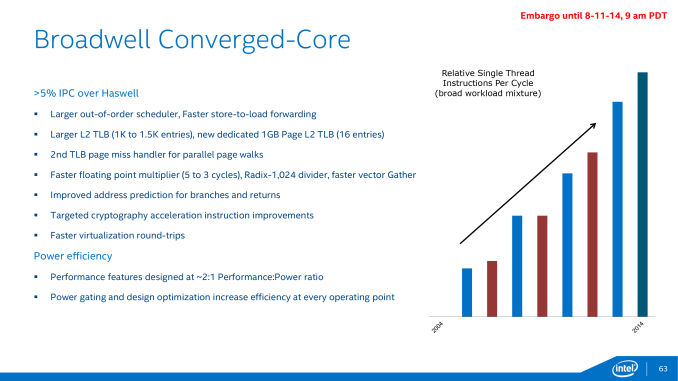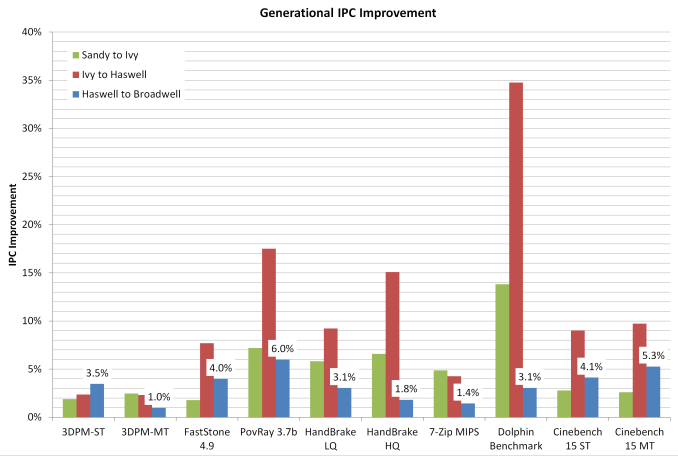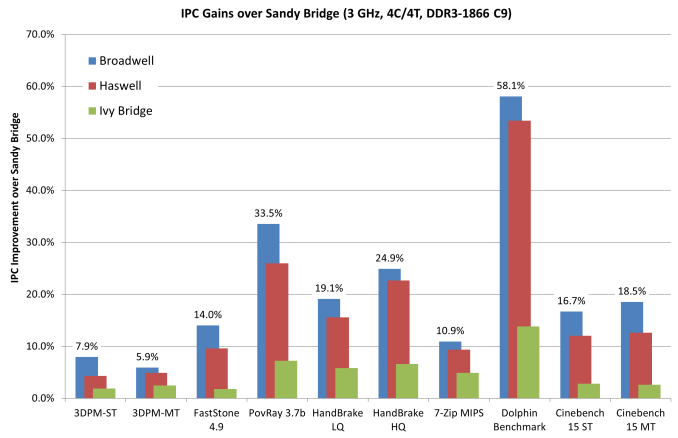The Intel Broadwell Review Part 2: Overclocking, IPC and Generational Analysis
by Ian Cutress on August 3, 2015 8:00 AM ESTConclusions: Broadwell Overclocking, IPC and Generational Gain
For everyone who has been in the PC industry for a decade or more, several key moments stand out when it comes to a better processor in the market. The Core architecture made leaps and bounds over the previous Pentium 4 Prescott debacle, primarily due to a refocus on efficiency over raw frequency. The Sandy Bridge architecture also came with a significant boost, moving the Northbridge on die and simplifying design.
Since then, despite the perseverance of (or soon to be mildly delayed) Moore’s Law, performance is measured differently. Efficiency, core count, integrated SIMD graphics, heterogeneous system architecture and specific instruction sets are now used due to the ever expanding and changing paradigm of user experience. Something that is fast for both compute and graphics, and then also uses near-zero power is the holy-grail in design. But let’s snap back to reality here – software is still designed in code one line at a time. The rate at which those lines are processed, particularly in response driven scenarios, is paramount. This is why the ‘instructions per clock/cycle’ metric, IPC, is still an important aspect of modern day computing.
As the movement from Haswell to Broadwell is a reduction in the lithography node, from 22nm to 14nm, with a few silicon changes, Broadwell was a mobile first design and launched in late 2014 with notebook parts. This is typical with node reductions due to the focus on efficiency overall rather than just performance. For the desktop parts, launched over six months later, we end up with an integrated graphics focused implementation purposefully designed for all-in-one PCs and integrated systems rather than a mainstream, high end processor. The i7 and i5 are both targeted at 65W, rather than 84W/88W of the previous architecture. This gives the CPUs a much lower frequency and without a corresponding IPC change, makes the upgrade path more focused for low end Haswell owners, those who are still several generations behind wanting an upgrade or those who specifically want an integrated graphics solution.
In our first look at Broadwell on the desktop, our recommendation that it would only appeal to those who need the best integrated graphics solution regardless of cost still stands. Part 2 has revealed that clock-for-clock, Broadwell gives 3.3% better performance from our tests although DRAM focused workloads (WinRAR) can benefit up to 25%, although those are few and far between. If we compare it back several generations, that small IPC gain is wiped out by processors like the i7-4790K that overpower the CPU performance in pure frequency or even the i7-4770K which still has a frequency advantage. From an overall CPU performance standpoint out of the box, the i7-5775C sits toe-to-toe with the i7-4770K with an average 1% loss. However, moving the comparison up to the i7-4790K and due to that frequency difference, the Broadwell CPU sits an average 12% behind it, except in those specific tests that can use the eDRAM.
There’s nothing much to be gained with overclocking either. Our i7-5775C CPU made 4.2 GHz, in line with Intel’s expectations for these processors. If we compare that to an overclocked 4.6 GHz i7-4790K, the 4790K is still the winner. Overclocking on these Broadwell CPUs still requires care, due to the arrangement of the CPU under the heatspreader with the added DRAM. We suggest the line method of thermal paste application rather than the large-pea method as a result.
Looking back on the generational improvements since Sandy Bridge is actually rather interesting. I remember using the i7-2600K, overclocking it to 5.0 GHz and remembering how stunned I was at the time. Step forward 4.5 years and we have a direct 21% increase in raw performance per clock, along with the added functionality benefits of faster memory and a chipset that offers a lot more functionality. If you’ve been following the technology industry lately, there is plenty of talk surrounding the upcoming launch of Skylake, an architectural update to Intel’s processor line on 14nm. I can’t wait to see how that performs in relation to the four generations tested in this article.
*When this article was initially published, inaccuracies were made in calculating the IPC gain in the timed benchmarks. The article has been updated to reflect this change. In light of the recalculation,overall conclusions are still correct.
Interesting related links:
The Intel Broadwell Desktop Review: Core i7-5775C and Core i5-5675C Tested (Part 1)
AnandTech Bench CPU Comparison Tool














121 Comments
View All Comments
Shadowmaster625 - Monday, August 3, 2015 - link
I never understood the "pea size" method. Peas come in many different sizes. And it seems to me that the size of a typical pea is rather large. You need something standard, like a bb. They are a standard size, 0.177 caliber, and three of them in a line seems to work best.Pissedoffyouth - Monday, August 3, 2015 - link
I put a grain of rice size in the middle. get a glasses cloth and rub it on both the heatsink and the heat spreader, and rub it off. Should be a slight tinting left.Then put another grain of rice size in the middle and screw the heatsink in. Done.
You want to use the bare minimum amount of paste.
zodiacfml - Monday, August 3, 2015 - link
Very polarizing CPU. Any ideas why Intel doesn't have Crystalwell in laptops? I don't want a discrete GPU anymore in mobile due to risk of dead GPUs/Mobo after a few years.zodiacfml - Monday, August 3, 2015 - link
Oh, nevermind! I found them.extide - Monday, August 3, 2015 - link
They do, but the CPU's with Crystalwell are quite expensive, so most OEM's shy away from them because it is too expensive for a cheap laptop, and then a higher end laptop they put a dGPU in.In my next laptop, I want a Iris Pro (w/ Crystalwell) chip, and NO DGPU! I don't want the power consumption, and Iris Pro is plenty enough performance for what I do on a laptop. Unfortunately, it's kinda hard to find high-ish end laptop's with that config. :(
Gigaplex - Monday, August 3, 2015 - link
Before Broadwell, the only way to get Crystalwell was in the mobile chips.varg14 - Monday, August 3, 2015 - link
Until my pretty much 5 year old Sandy Bridge 2600k that runs between 4.5-5.0ghz PCIE 2.0 @ 8x lane speed does not bottleneck a dual GPU setup to the point it can not push at least 60FPS at 3440-1440 resolution on my 34" 21/9 LG 34UM95 monitor their is no reason to upgrade whatsoever.Also with DX12's reduced CPU overhead any new DX12 games should run great with a old Sandy CPU. Also DX12 Should greatly improve the performance of my EVGA's GTX 770 4gb Classified SLI setup since it will split frame render instead of alternate frame rendering allowing the vram to be sorta stacked since each card is only rendering half a frame instead of a whole frame allowing the 4gb of Vram on each card to act like one 8GB card.
PrinceGaz - Monday, August 3, 2015 - link
Skylake should be the big one that has been waited for since Sandy Bridge; Ivy Bridge's tick reduced overclockability because of the process node, Haswell improved IPC but added the onboard voltage regulator which made overclocking at that node still worse, and Broadwell keeps the voltage regulator whilst further focussing on lower power.I'm not saying Skylake will go to the dizzying raw gigahertz of Sandy Bridge, but two generations of tocks, and the removal of the onboard voltage regulator, and if we're lucky, the improved thermal compound used in Haswell Devil's Canyon, could together make for a significantly faster chip; one which may well see the upper ends of the 4.x GHz attainable.
Impulses - Monday, August 3, 2015 - link
Fingers crossed, if it can come near SB levels of OC I'd be complacent... Just enough for the IPC advantage not to be mitigated by raw clock speed, I'm really upgrading my 2500K for the platform anyway (M.2 in particular) but it'd be nice to get a halfway decent CPU upgrade.Aspiring Techie - Monday, August 3, 2015 - link
The Broadwell equivalent of a Sandy Bridge 5.0 GHz overclock in raw instruction throughput (assuming that Skylake doesn't have any improvement in ipc) is 4.3 GHz. A 4.6 GHz Haswell overclock is equivalent to a 4.4 GHz Broadwell. Broadwell wasn't designed for the desktop, so it isn't designed for good overclocking. If Skylake's consumer flagship has the same clocks as the 4790K with say 10% ipc over Broadwell, then at 4.4 GHz, it has will have the same instruction throughput as a 5.0 GHz Haswell or a 5.7 GHz Sandy Bridge chip. The overclock should increase as the 14nm process becomes more mature, so less voltage is needed for better clocks. If Intel does it right, then everyone will be happy (except AMD since Zen would be screwed over).